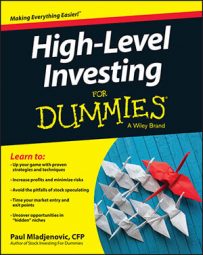People who consistently do well with short selling tend to follow a plan in terms of both identifying stocks that are shortable and watching for market signals as to the timing. Fundamental analysis — looking at the company's numbers (sales, profits, and so on) and related data (industry factors, market factors, and the like) — will help you create a pool of candidates from which to choose for your shorting strategy.
Normally, you'd use fundamental analysis as a filter to separate the good from the bad and the ugly. In this case, you discard the good, embrace the bad, and become truly enamored with the ugly. With shorting, ugly is beautiful.
Short selling in bear markets
What kind of market are you trading in?
Short selling in a bull market is akin to paddling upstream. Sometimes it's like paddling up Niagara Falls with tennis rackets rather than paddles. Yes, there are bearish opportunities inside bull markets; after all, some companies have bad-hair days (and weeks and months) in any given market conditions. But it's just easier to short when the general market is struggling and falling. After all, if a rising tide raises all boats, it's better to bet on sinking boats in a tsunami.
Given past market data, bear markets tend to come around about once every 3.5 years (give or take a few months) and tend to last about 18 months (give or take a few weeks). For bullish investors, that length of time tends to mean half a bottle of aspirin (give or take a few tablets).
It makes the most sense to slowly step into a shorting (or other bear market) strategy when a bull market is looking very toppy and has all the indicators of running out of steam and starting to head downward. Selling at the top is, of course, much easier said than done. But fortunately, short-selling opportunities are plentiful even after a bull market has already ended and started to zigzag down.
Looking at the company's sales and earnings
If a good company has rising sales and earnings, then a weak company has shrinking sales and earnings or, even better, no earnings (that is, net losses).
View the income statements from at least the most recent three years to see where the company is trending. If sales have been flat or falling for three years and you also see falling net income to the point of losses, then you have yourself a shorting candidate. Finding this data — which basically shows total sales minus total expenses with the net income or loss — is not difficult. Websites such as MarketWatch and Yahoo! Finance are good for starters.
Seeking out unsustainable and/or rising current debt
Unsustainable debt has been the wrecker of many companies, big and small (not to mention millions of individuals and some countries, too). The size and scope of a company's debt can be found on its balance sheet. A balance sheet summarizes (in order) the company's assets, liabilities, and net worth (which equals total assets minus total liabilities). Compare the most recent balance sheet with the balance sheets of the prior two years to see whether a trend is unfolding with unsustainable debt.
The same sites that provide income statements also provide the balance sheet as well.
While long-term investors look at the company's total debt, a short seller is more concerned about the sustainability of current debt. Total debt or long-term debt may be an issue, but it's more likely a long-term issue. Short sellers don't worry about debt difficulties unfolding years into the future. They want to see immediate difficulties because shorting isn't typically a long-term pursuit.
Look at the company's financial ratios for clues about how strong or how weak a company is. An appropriate ratio to look at, for example, is the quick ratio, which compares the current assets of the company (such as cash and accounts receivables, excluding inventory) to current liabilities (debts that need to be paid within 12 months). The quick ratio is categorized as a liquidity ratio, meaning it measures those assets that are liquid (or able to be converted to cash) and can be used for immediate bills and liabilities. Inventory is excluded from this ratio, but inventory isn't always as liquid as it can be.
Obviously, if the current assets exceed current liabilities, that's good for the company. Ideally, the current assets should exceed current liabilities by a wider margin, such as 2-to-1 or better. In other words, if a company has current liabilities of $1 million, it's better to have current assets of $2 million or better so the company has some financial breathing room.
A company would have a negative quick ratio if current liabilities exceeded current assets. This indicates that financial difficulties will arise in the short term if something positive doesn't happen.
Couple issues of current debt with, say, bad sales and earnings numbers for a company, and you see an attractive short-selling opportunity for a speculator. If a company has stagnating or shrinking sales, a net loss on the income statement, and a negative quick ratio, then you have a short-sale candidate.

